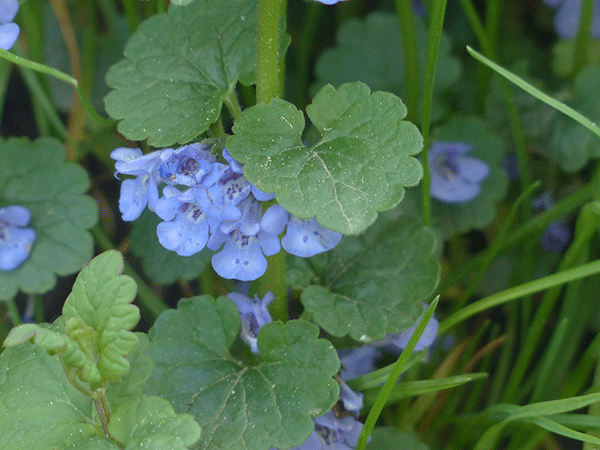Description
Henbit, Lamium amplexicaule, is in the mint family. Like other mints, it has a square stem and lipped tubular flowers that some people refer to as a giraffe's head. Flowers emerge from the stem at the leaf axils, where the leaf joins the stem. The color of the flowers range from pinkish to purple.

Henbit is a winter annual, meaning its seeds will germinate in the fall, and so will be ready in the early spring to quickly mature and flower. Flowering can start in March in Nebraska. Sometimes a field will be covered with a beautiful (in the eye of the beholder) carpet of purple henbit flowers.
The plant generally grows four to six inches tall, but can get up to a foot tall. It prefers sunny spots in moist, fertile soils, but is adaptable to dry and shady areas. Henbit has a taproot that is somewhat fibrous. It is easy to pull from moist soil.
Lifecycle
When the temperatures get warm the plant dies, usually sometime in June. Its life can be extended, however, if cool temperatures persist into summer.
Henbit can be a problem in farm fields, thinned turf areas, and gardens. Although there are claims of henbit causing staggers in farm animals in Australia, there are no known cases of poisoning in this country. Wild food aficionados claim that henbit is a tasty edible that can be prepared in a number of ways. You can find many websites with details. The seeds, called nutlets, are an important food for some birds.

Mistaken Identity
Henbit is often confused with two other mints: Lamium purpureum (Purple Deadnettle), and Glecoma hederacea (Ground Ivy/Creeping Charlie). All three have square stems, and tubular mint-type flowers that emerge from the leaf axils.
The upper leaves on henbit clasp the stem but lower leaves have petioles (or stalks) attaching the leaves to the stem. Henbit leaves can appear scalloped, but the upper leaf edges are more jagged.

The leaves of Creeping Charlie on the other hand, have petioles all the way to the top of the stem. All of the leaves appear to be more scalloped. As a perennial, Creeping Charlie will be green through frost.
Purple Deadnettle is an annual with more pointed leaves that look as though they are stacked on top of each other. All the leaves have petioles.
Food for Pollinators
Although it is considered a weed in farm fields and home landscapes, it is an important early spring food source for pollinators. The flowers provide nectar and pollen for honeybees and bumblebees, so tolerating henbit in your early spring garden or even learning to enjoy the flowers, is a boon to these beneficial insects.
2/1/2018

